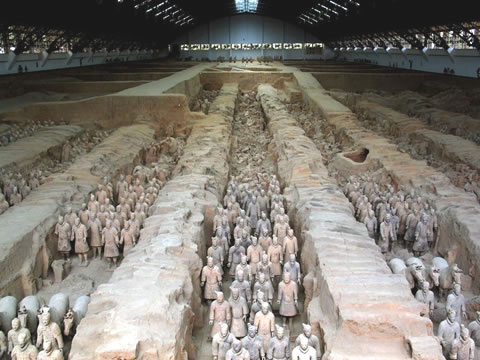 he terracotta warriors and horses, created about 2,200 years ago, were found in 1974 on the east side of the tomb of the First Emperor Qin Shihuang (259 BC - 210 BC) near Xi'an.Emperor Qin's Terra-cotta army pits are the large attendant pits, located about 1 mile (1.5 kilometers) east of the Emperor QinShihuang's mausoleum, symbolizing the main defending force that guarded the capital before Emperor Qin died .Qin Shi Huang (259-210BC) was the first emperor of the Qin Dynasty and he was the founder of China’s first empire. He expanded his military strength building an army of one million professional soldiers. He started the construction of the Great Wall.
he terracotta warriors and horses, created about 2,200 years ago, were found in 1974 on the east side of the tomb of the First Emperor Qin Shihuang (259 BC - 210 BC) near Xi'an.Emperor Qin's Terra-cotta army pits are the large attendant pits, located about 1 mile (1.5 kilometers) east of the Emperor QinShihuang's mausoleum, symbolizing the main defending force that guarded the capital before Emperor Qin died .Qin Shi Huang (259-210BC) was the first emperor of the Qin Dynasty and he was the founder of China’s first empire. He expanded his military strength building an army of one million professional soldiers. He started the construction of the Great Wall.In preparation for his death he built a replica of his kingdom underground and he was finally laid to rest in the underground palace at its centre. It took over 720 000 people, 37 years to build. The terra-cotta army were created to defend his underground kingdom from attack. When they were first found it was believed that the terra-cotta warriors are all individually designed, based the faces of the Emperors actual soldiers. However, it has since been proved that all the soldiers are based on ten basic designs.The site is now the famous Terra-cotta Museum, which consists of three main buildings, Pit 1, Pit 2 and Pit 3. The three pits occupy an area of 22,000 square meters, housing about 8,000 life-size pottery warriors and horses.
 Pit No. 3 is situated 25 metres to the north of Pit No. 1 and to the west of Pit No. 2. Tthe pit is in the concave shape with 520 square metres. From the pit were discovered one chariot, four terra-cotta horses and 68 clay armoured warriors. In Pit No. 3 were only unearthed one kind of weapon called "shu", which had no blades and are said to be used by the guards of honour. Discovered also in this pit were a re- maining deer-horn and animal bones. This is maybe the site where sacrificial offerings and war prayers were practiced.n December 1980, two sets of large painted bronze chariots and horses were unearthed 20 metres west of the tomb of the first Emperor of the Qin Dynasty.
Pit No. 3 is situated 25 metres to the north of Pit No. 1 and to the west of Pit No. 2. Tthe pit is in the concave shape with 520 square metres. From the pit were discovered one chariot, four terra-cotta horses and 68 clay armoured warriors. In Pit No. 3 were only unearthed one kind of weapon called "shu", which had no blades and are said to be used by the guards of honour. Discovered also in this pit were a re- maining deer-horn and animal bones. This is maybe the site where sacrificial offerings and war prayers were practiced.n December 1980, two sets of large painted bronze chariots and horses were unearthed 20 metres west of the tomb of the first Emperor of the Qin Dynasty.


 They were listed as No.1 and No.2 respectively according to their discovery. They were then enclosed in a wooden coffin and buried in a pit seven metres deep. When excavated, the chariots and horses were seriously damaged due to the decayed wooden coffin and the collapse of earthen layers. No.2 bronze chariot and horses were found broken into 1555 pieces when excavated. After two-and-half years of careful and painstaking restoration by archaeologists and other experts they were formally open to the public on October 1, 1983. No.1 bronze chariot and horses were also open to the public in 1988.
They were listed as No.1 and No.2 respectively according to their discovery. They were then enclosed in a wooden coffin and buried in a pit seven metres deep. When excavated, the chariots and horses were seriously damaged due to the decayed wooden coffin and the collapse of earthen layers. No.2 bronze chariot and horses were found broken into 1555 pieces when excavated. After two-and-half years of careful and painstaking restoration by archaeologists and other experts they were formally open to the public on October 1, 1983. No.1 bronze chariot and horses were also open to the public in 1988.